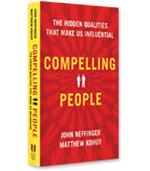
Why did I choose this resource?
This resource was chosen for me to learn how to become a compelling individual.
What did you learn from it?
I learned the importance of demonstrating a balance between strength and warmth; and how they can be communicated both verbally and nonverbally.
Key Knowledge
- People judge each other based on two qualities
- strength = respect = Leadership
- warmth = affection = Team Member
- Very rare for people to posses both qualities in balance
- First judgment – physical – automatic – create stereotype
- gender
- body type
- looks
- ethnicity
- age
- All humans stereotype, part of human nature. Helps our minds put order to the world.
- Difference races tend to steer conversations towards different topics. Engaging in all forms of dialogue will help you portray both strength and warmth.
- Second judgment – character
- Actions
- Interactions
- All behaviors can be changed; some take more time but can be altered by a conscious decision
- Nonverbal communication – feeling – trust – strongest part of overall impression you make
- facial expressions, posture, gestures, vocal tone, and actual words
- when aligned – trusted
- when unaligned – conflicted, lying
- facial expressions, posture, gestures, vocal tone, and actual words
- Space
- Strength
- make themselves at home
- move about freely
- take up a lot of space
- good posture (vertical space) – easier to control
- strong gait – long stride, chest out, head up – easier to control
- gesture – deliberate and graceful movements, poise – harder to control
- Warmth
- being in close proximity to others
- Strength
- Face
- Strength
- Flexed lower eyelid, flexed eyebrows – “steely gaze”
- Warmth
- smiles – strong, influential, contagious, and known worldwide
- can sometimes be associated with strength
- smiles – strong, influential, contagious, and known worldwide
- Strength
- Voice
- Pitch
- Strength – low
- Warmth – variation
- Volume
- Strength – high
- Warmth – low
- Rate
- Combination of words per second, uses of pauses, and fluency
- Most effective when combined with low pitch and good volume
- Tone
- influence – lead conversation = Strength
- mimicry – depicts empathy = Warmth
- consistency
- immense = Strength
- variability = Warmth
- Pitch
- Style – indicates your attitude as well as your tastes
- Words
- Strength – abundant vocabulary with direct active verbs
- Verbal Warmth: The Circle
- Get in the circle – identify and connect with the audience
- Create “Yes Momentum” – Yes must be the first response received from the audience
- Displays strength
- Communicating in the workplace
- with Bosses
- Easier/safer to convey warmth
- “no surprises” – shows loyalty
- keep them informed – shows you have the same values
- Easier/safer to convey warmth
- with Subordinates
- Establish strength
- Convey warmth
- with Bosses
- The Big Pitch
- Strength
- Have something of value to offer, similar business dynamic, and you can deliver
- Warmth
- Have same interests, good cultural fit, and in it for the long run
- Strength
- Five Principal Leadership Skills – balancing strength and warmth
- Emotional intelligence – drives others to action, strength and warmth
- Communications – portrays both strength and warmth
- Visions – ability to share the vision of the future, related to warmth
- Machiavellian political skills – ability to evaluate the competition, related solely to strength
- Contextual intelligence – ability to evaluate a situation and decide on the actions to be taken, strength and warmth
- Strength and warmth are energies, life forces, which work together.
- Strength – sense of mastery
- Warmth – sense of belonging
- Bring them together, “It is actually emotionally engaging in the moment, understanding and feeling your own actions as expressions of your strength and warmth. In those moments, you feel powerful and deeply connected to people. That makes you compelling to others, because it makes you compelling to yourself.”
How are you using what you learned?
I am using what I learned to improve the impressions I have on others. This includes how I present myself, my actions, and the things I say.
Key Changes / Key Actions
- Improve gait and posture
- Be mindful of my voice (pitch, volume, rate, and tone)
- Be mindful of my facial expressions
Source
- Name : Compelling People
- Author : John Neffinger and Matthew Kohut
- Summary.com: Link to Book




